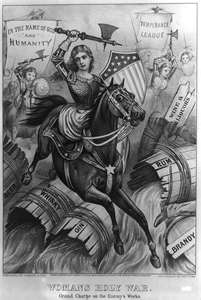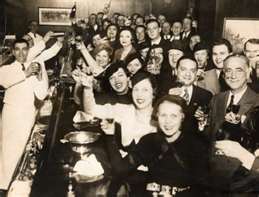The Temperance movement blamed alcohol for many of society’s ills. Saloons were places of evil. Husbands squandered their earnings there, went to work after drinking at lunch and were injured at their jobs, came home drunk and neglected or abused their families.
 Temperance advocates in the 1830s — hundreds of thousands of them — initially promoted abstinence from alcohol. By the 1850s they wanted alcohol prohibited entirely and 13 states had enacted prohibition legislation by 1855. The Civil War (1861-1865) sidelined temperance sentiment and most decisions related to its efforts were reversed.
Temperance advocates in the 1830s — hundreds of thousands of them — initially promoted abstinence from alcohol. By the 1850s they wanted alcohol prohibited entirely and 13 states had enacted prohibition legislation by 1855. The Civil War (1861-1865) sidelined temperance sentiment and most decisions related to its efforts were reversed.
Growth of the liquor industry after the war and seemingly pervasive drunkenness at the time revived social reformers. Neither political party wanted to address the issue officially so the National Prohibition Party came to be in 1869. Together with the Woman’s Christian Temperance Union (1874), the Anti-Saloon League (1893), and other Temperance groups advocates launched a national drive in 1913 for a constitutional amendment prohibiting manufacture and sale of alcoholic beverages. Congress passed such an amendment in 1917.
By January 1919, 36 states had ratified the 18th Amendment to the Constitution calling for nationwide Prohibition. To implement it, Congress passed the Volstead Act in October of that year which stated: “no person shall manufacture, sell, barter, transport, import, export, deliver, or furnish any intoxicating liquor except as authorized by this act.” “Intoxicating liquor” meant any beverage containing more than 0.5% alcohol. Exceptions were for medicinal, industrial, and religious purposes.
Prohibition quickly became a study in unintended consequences. A meager force of 1,520 agents was charged with catching law-breakers in a country with 20,000 miles of coastline and international borders to bring liquor across and 3,500,000 square miles of land in which to hide a still. Bootlegging and smuggling became big business. Criminal gangs, Al Capone’s being the most notorious, took over production, importation, and distribution of alcohol. They fought over territory in sometimes violent confrontations. They bribed underpaid public officials, hired expensive lawyers when caught, discouraged “snitches” with violence, and all the while brought a constant flow of liquor to a thirsty public.
Actual consumption of alcoholic beverages was not prohibited. A person couldn’t make or buy alcohol but could drink it if he could find it. Public drinking, once a regular macho pastime, began to die out as saloons gradually disappeared, only to be replaced by drinking in the more private speakeasies. This led to increasing social acceptance of women in establishments providing drinks and entertainment; cocktails and cocktail parties became popular with respectable ladies and gentlemen. Gangsters became folk heroes; police became the enemy. Breaking the law was now glamorous and fun.
Thus the perfect world promised by the Temperance movement became just another fantasy. Drinking increased, gangster mobs drove up the crime rate, respect for the law declined, and the ordinary citizen who simply wanted a drink risked being treated as a criminal. The 18th Amendment lost legitimacy in the public eye and anti-Prohibition thinking gained strength all during the 1920s. The 1929 Stock Market crash and the beginning of the Great Depression dramatically swung opinions. People needed jobs; the government needed money. Making alcohol legal again would give both.
Thirty-six states ratified the 21st Amendment to the Constitution by December 1933 repealing the 18th and returning control of alcoholic beverages to individual states. Some states repealed their laws at once; others maintained them for many years. Mississippi was the last state to repeal in 1966.
Will Prohibition ever return? Today each liquor distillery pays several million dollars a week in liquor taxes. Don’t look for it anytime soon.

